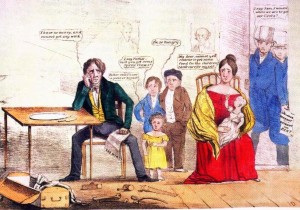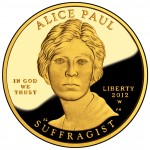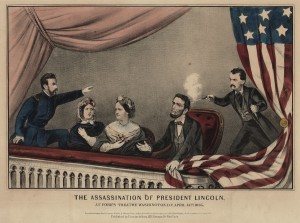ANA MEMBERS: I NEED YOUR HELP!!
Dear ANA Member:
I want to run for the ANA Board of Governors, but the pandemic and a project that took too long to complete prevented me from collecting the signatures for the petition I need to appear on the ballot.
I do not have enough signatures on the petition to appear on the ballot. If you are an ANA member, can you please sign a petition and send it back to me so that I can appear on the ballot?
If you can help:
- Download a PDF of the petition from → this link.
- Sign the petition and please include your ANA Member Number.
- Use your smartphone and take a picture of the top part with your signature and email the image me at scott@coinsblog.ws.
- If you can scan the paper and send it as a PDF, that would also help. In either case, I need the image of your signature with your ANA member number.
Your signature is not an endorsement of my candidacy — although I would appreciate your support. This exercise will allow me to appear on the ballot.
The deadline to submit signed petitions is the close of business at the ANA headquarters in Colorado Springs on Monday, March 1, 2021. I would like to submit the signatures by noon Eastern Time (where I live) on Monday.
NOTE: Once the signatures are submitted and verified by the ANA, I am not going to keep the files.
Women on 20s gets congressional attention
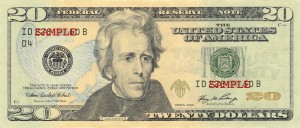 A few weeks after the Women on 20s group began their campaign, they gained the attention of congress to have two bills submitted to require the change be made.
A few weeks after the Women on 20s group began their campaign, they gained the attention of congress to have two bills submitted to require the change be made.
First up is Sen. Jeanne Shaheen (D-NH) who introduced Women on the Twenty Act (S. 925) on April 14, 2015 and referred to the Committee on Banking, Housing, and Urban Affairs, the bill is eight co-sponsor. All eight co-sponsors are Democrats and six are women.
Simply, the bill seeks to add a new paragraph to the Federal Reserve Act (12 U.S.C. § 418) to say:
The Secretary of the Treasury shall convene a panel of private citizens of the United States to advise and make recommendations to the Secretary regarding the likeness of a woman to appear on the face of $20 Federal reserve notes. In carrying out the requirements of the preceding sentence, each of the Secretary and the panel shall consider and weigh input provided by the American people.
While you read that paragraph, you have to understand that there is a little Washington-speak in the proposed law. All it says is that the Secretary is required to appoint a panel of private citizens, not government employees or appointees, to make a recommendation. It does not say that the Secretary is required take the committee’s recommendation nor does it it say that the Secretary is to do anything with the recommendation.
Essentially, unless the wording is changed, there is nothing in the above statement to require a woman appear on the $20 Federal Reserve Note. “Thank you for your recommendation,” a Secretary of the Treasury can say, “and have a nice day.”
There is precedent for the Secretary of the Treasury to ignore recommendation. Famously, Secretary of the Treasury Andrew Mellon ignored the recommendation by the Washington Birthday Bicentennial Committee and the U.S. Commission of Fine Arts to use the design by Laura Gardin Fraser. Mellon suggested that Fraser’s design was not based on the bust of Washington by Jean-Antoine Houdon and selected the design by John Flanagan. Even though few thought Flanagan’s design was better, Mellon, a known misogynist, refused to accept a recommendation.Adding to the fray is a bill introduced by Louis Gutierrez (D-IL) whose title currently appears similar to that of Sen. Shaheen’s bill. Gutierrez’s bill (H.R. 1910) has no co-sponsors and was assigned to the House Financial Services Committee. As this is being written, the bill has not been published by the Government Printing Office making it difficult to compare this with S. 925.
Considering my last post about this topic, it will be interesting to see how this turns out. If I was to guess, one of the bills will be passed at the end of a session either by unanimous consent or an overwhelming vote in favor. A design will be produced but not in time to celebrate the 100th anniversary of suffrage. The wheels of politics and bureaucracy moves too slow and the engravers need time to engrave the plates.
Coin image courtesy of the U.S. Mint.
Langbords win their Double Eagles… for now!
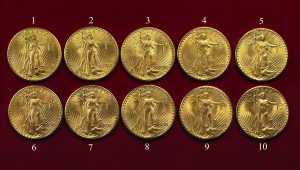
The ten 1933 Saint-Gaudens Double Eagles confiscated by the government from Joan Lanbord, daughter of Israel Switt.
The original suit was filed in the U.S. District Court in Philadelphia by Barry H. Berke on behalf of Joan Langbord, the surviving daughter of jeweler Israel Switt, and her sons Roy and David. Berke is no stranger to these types of law suits. He represented the plaintiffs in the case that resulted in the sale of the Farouk coin in 2002. In July 2011, the jury returned a verdict declaring the coins to be government property.
The verdict left a lot of question about the legality of pattern coins. One example cited was the 1974-D Aluminum cent. However, on April 6, a federal judge in California ruled that the coin could have legally left the Denver Mint. This does not end the battle for the cent. All it does is dismisses the government’s claim for summary judgement against the plaintiffs Randall Lawrence and Michael McConnell.This case is different since it is further along and about what was to be a circulating coin.
The ruling, written by Judge Marjorie O. Rendell,† centers around the government’s use of Civil Asset Forfeiture Reform Act of 2000 (CAFRA). CAFRA was passed as a “eact[ion] to public outcry over the government’s too-zealous pursuit of civil and criminal forfeiture” and as an “effort to deter government overreaching.” The government said that the Langbords did not file their suit within the 90-day time period. However, the ruling says that it does not imply because “Congress has specifically enumerated theft or embezzlement of government property as one of the crimes to which CAFRA applies.” Since the government called the assets stolen and then ignored the Langbords’ claim for the government to return the coins, they did not prove that the assets were embezzled and CAFRA does not apply.
In the areas where CAFRA did apply, the government did not respond to the Langbords’ request for return of the assets within the 90-days required by law. “The Langbords are correct in urging that we reject these arguments. The Government was required either to return their property or to institute a judicial civil forfeiture proceeding within 90 days of the Langbords’ submission of a seized asset claim.”
The three judge panel concluded “he Langbords are entitled to the return of the Double Eagles.” The appeal overturns the lower court’s ruling and the Appeals Court “will remand for the District Court to order the Government to return the Double Eagles to the Langbords.”
This may not be the end of the story. The government can ask for a temporary stay of the order in order to file an appeal. At that point the government attorneys can either appeal the ruling by the three-judge panel to the full Appellate Court (a full 9 judge panel) or directly to the Supreme Court.
My opinion: considering how the government has behaved throughout the saga of these coins, I think they will try to appeal this ruling to the full Third Circuit. It drags the case out longer and allows the government to put its considerable heft against the the Langbords. I do not think the government will settle this suit in a similar manner that the King Farouk coin was settled. However, if I understand the procedures correctly, the Langbords can claim that the case has significant public interest and ask for it to be heard by the Supreme Court. The Supreme Court then will decide to hear the case or let it be heard by the Third Circuit first. Regardless, I think the next stop is the Supreme Court where the most fascinating story in U.S. numismatics will be settled.
Or will it?
Image of the Aluminum cent originally from the Smithsonian Institute.
Do we dump Andy for a woman?
 During the course of searching for information, I stumbled upon the website for Women on 20s. It is a site dedicated to replacing the image of President Andrew Jackson with a woman by 2020. The group has targeted the $20 Federal Reserve Note to be replaced 2020 because it is the 100th anniversary of the passage of the 19th Amendment that granted women the right to vote.
During the course of searching for information, I stumbled upon the website for Women on 20s. It is a site dedicated to replacing the image of President Andrew Jackson with a woman by 2020. The group has targeted the $20 Federal Reserve Note to be replaced 2020 because it is the 100th anniversary of the passage of the 19th Amendment that granted women the right to vote.
Jackson is being targeted because as we look back through the long lens of history, he was not exactly a model person judging by today’s standards. During the War of 1812, Jackson led U.S. Army troops against native tribes working with the British against the United States to regain the lands taken following the colonies’ independence. It was said that Jackson’s troops were brutal against the native tribes on his orders, killing them rather than taking prisoners.
After beating back the British in the Battle of New Orleans, Jackson declared martial law in New Orleans and used his troops to enforce martial law. Aside from having a magistrate arrested who sided with a newspaper reporter writing who was arrested for writing negatively about his rule, he had members of the local militia who sided with the British executed without trial and went on to use it as propaganda to allegedly maintain order.
As president, Jackson’s policies to relocated native tribes lead to the Indian Removal Act that codified his policies. This lead to the “Trail of Tears” that forced the relocation of Cherokee, Muscogee, Seminole, Chickasaw, and Choctaw nations from their ancestral homelands in the southeast to an area west of the Mississippi River that had been designated as Indian Territory. It is considered the most violent and brutal act against the native tribes in United States history.
To have Jackson’s portrait on the United States central banks’ currency is also a bit ironic. Jackson was against the concept of a central bank and refused to renew the charter of the Second Bank of the United States and vetoed the bill to continue its charter. After winning election in 1833, Jackson withdrew all of the country’s funds from the bank limiting the bank’s ability to conduct business. He gave power to local banks to lend money and issued the Specie Circular, an executive order requiring government transaction be done in gold and silver coin (specie).
With the western expansion and federal lands being made for sale and the requirement that duties were to be paid in gold and silver, this created a run on banks that could not provide the hard currency necessary for people to exchange their banknote. Although Jackson paid off the country’s debt in 1835, the only year it has ever been paid off, the squeeze on currencies, lack of central management of money, corrupt bank practices, and reckless land speculation by railroads lead to the Panic of 1837. The resulting depression lasted five years and included the default of many banks and the treasuries of many states. Remember, this was long before the deposits were insured by the federal government.The Women on 20s organization does not believe that this should be the legacy honored on U.S. currency. But if we look into the history of all of the men on U.S. currency, there are aspects of their pasts and personal lives that would make some blush, including Benjamin Franklin’s common law wife and illegitimate son.
 Women on 20s do recognize that suffragette Susan B. Anthony did appear on a one dollar coin but the coin failed because of its confusion with the quarter. They also recognize that Sacagawea, the Shoshone guide to Meriwether Lewis and William Clark, appears on the current one-dollar coin. Aside from the 2003 Alabama State Quarter, no other woman has appeared on circulating coinage (they do not count commemorative issues). Since neither dollar coin has circulated well and since the Alabama quarter was a temporary issue, the organization believes a better tribute is warranted.
Women on 20s do recognize that suffragette Susan B. Anthony did appear on a one dollar coin but the coin failed because of its confusion with the quarter. They also recognize that Sacagawea, the Shoshone guide to Meriwether Lewis and William Clark, appears on the current one-dollar coin. Aside from the 2003 Alabama State Quarter, no other woman has appeared on circulating coinage (they do not count commemorative issues). Since neither dollar coin has circulated well and since the Alabama quarter was a temporary issue, the organization believes a better tribute is warranted.
In what looks like an addendum to their argument, they mention that a portrait of Martha Washington appeared on the Series 1886 (Fr. #215) and 1891 (Fr. # 223) $1 Silver Certificates. Both Martha and George Washington appeared on the reverse of $1 Series 1896 Educational Series note (Fr. #224).
To decide who they will try to lobby to appear on the $20 note, the organization started with 15 candidates. Voters were asked to select thee of the 15 candidates in this preliminary round. The top vote-getters will be subject to another final voting round.
In the first round, the 15 candidates were Alice Paul (appeared on the 2012 First Spouse gold coin), Betty Friedan, Shirley Chisholm, Sojourner Truth, Rachel Carson, Rosa Parks, Barbara Jordan, Margaret Sanger, Patsy Mink, Clara Barton, Harriet Tubman, Frances Perkins, Susan B. Anthony (appeared on the 1979-1999 dollar coin), Eleanor Roosevelt (appeared on the 2014 First Spouse gold coin), and Elizabeth Cady Stanton.Women on 20s reported that 256,659 people had cast ballots when the first round ended on April 5, 2015. They reported that Eleanor Roosevelt, Harriet Tubman and Rosa Parks were named by as many as half of the voters as one of their top three. They added Wilma Mankiller to the final ballot. Mankiller, the first female Chief of the Cherokee Nation and the first female to be a chief of a native nation, was added because of a claimed “strong public sentiment that people should have the choice of a Native American to replace Andrew Jackson.”

Wilma Mankiller, the first female principal chief of the Cherokee Nation
Voting is open at the time this is being written. There is no closing date listed on their website.
Since congress does not control the design of the currency, Women on 20s will have to convince the Federal Reserve to change the design of the $20 Federal Reserve Note. If the Federal Reserve, whose chair is Janet Yellen, agrees to the change, they will work with the Bureau of Engraving and Printing for the design and the U.S. Secret Service to ensure that the appropriate anti-counterfeiting measures are included.
Design changes to any Federal Reserve Note can take 3-5 years to complete.
NOTE: I contacted the Women on 20s organization for comments via email. That email has not been returned at the time of writing this article. If they answer my questions, I will publish them in a follow up post.
Coin images courtesy of the U.S. Mint
Image of Wilma Mankiller courtesy of the Native American Encyclopedia.
Mrs. Lincoln, the president is dead
Joining the crowd in the room was Surgeon General of the United States Army Joseph K. Barnes, his assistant Charles Henry Crane, Lincoln’s personal physician Dr. Robert K. Stone, and Dr. Anderson Ruffin Abbott the first Black Canadian to be a licensed physician. With Barnes in charge, the examination and treatment proved beyond the capabilities of the medical arts of the time. By 7:22 AM on April 15, 1865, Abraham Lincoln, the 16th President of the United States of America had succumbed to his injuries.
While every president faces their shares of challenges, Abraham Lincoln was challenged with the morality of slavery and the breaking apart of the republic before it reached its 100th anniversary. He was so concerned about keeping the nation together that not only did he have Union troops shoot at what he considered fellow Americans, but he broke laws and violated the constitution in order to keep the country going.
Lincoln is remembered for his debates with Stephen Douglas, the Emancipation Proclamation, Gettysburg Address, his second inaugural address, the Civil War, the Homestead Act, three revenue-based (taxation) acts, and the National Banking Act that lead to the creation of the Bureau of Engraving and Printing. Aside from being the first president assassinated, there are other aspects of his presidency that is not widely discussed. Lincoln was known for either not enforcing laws he did not like or over enforcing laws to silence critics. While he did not condone a lot of the brutality especially from Generals Sherman and Grant, he did not condemn them either. Some historians suggest that his appointment of the young General George B. McClellan after the loss at the First Battle of Bull Run was to use him to manipulate the strategy to be more brutal against the Confederacy.
In a move that would have had any modern president excoriated, Lincoln ignored a writ of habeas corpus issued by Supreme Court Chief Justice Roger B. Taney. Lincoln became incensed with Taney after he authored the controversial Dred Scott v. Sanford decision that Lincoln highly disagreed with. Following the writ, Lincoln and his cabinet ignored Taney, a move that hurt him in many ways. Taney died miserable and poor after a long illness blaming Lincoln for his decline.
Even with these blemishes on his record, Abraham Lincoln is the second-most celebrated and honored president. For his accomplishments, Theodore Roosevelt listened to immigrant artist Victor David Brenner to honor Lincoln on a coin. As part of Roosevelt’s “pet crime,” a portrait of Lincoln design by Brenner has appeared on the one-cent coin for 117 years. Lincoln has also appeared on the reverse of the 2013 Illinois state quarter, as part of the depiction of Mount Rushmore on the 2006 South Dakota quarter, and the 2010 Lincoln presidential dollar. Lincoln also appeared on the 1918 Illinois 100th anniversary of statehood commemorative half dollar, 1991 Mount Rushmore commemorative coin series, and the 2009 commemorative silver dollar honoring the 200th anniversary of his birth.At one time there was a trivia question as to the only United States coin with a presidential portrait of a president on both sides of the coin: the Lincoln Memorial cent. If you look carefully in the memorial on the reverse, you can see the statue of Lincoln in the memorial making it the only coin of its time to have this distinction.
Aside from appearing on the current $5 Federal Reserve Note, Lincoln has appeared on notes of 10 different designs and denominations including the fourth issue 50-cents fractional note, $10 Demand Note, $500 Gold Certificate, and a $1 large size silver certificate.
In honor of Lincoln, spend at least one of those little copper-coated zinc cents remembering that if it was not for him, that coin might not have existed.
Image of the 1909-VDB cent courtesy of USAcoinbook.com.Image of the 2009 Lincoln commemorative dollar courtesy of the U.S. Mint.
Banknote image courtesy of AntiqueBanknotes.com.
Sunday morning numismatics on CBS
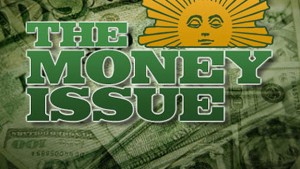 The U.S. Mint has sent out a press alert saying that CBS Sunday Morning will air two segments this Sunday, April 12th, that may be of interest to collectors. The first segment will focus on the artists and engravers in Philadelphia and the role they play in the coin-making process. The segment will also look at some of the Philadelphia Mint’s history.
The U.S. Mint has sent out a press alert saying that CBS Sunday Morning will air two segments this Sunday, April 12th, that may be of interest to collectors. The first segment will focus on the artists and engravers in Philadelphia and the role they play in the coin-making process. The segment will also look at some of the Philadelphia Mint’s history.
A second segment will look at the penny and the debate about whether or not it should be eliminated.
CBS is branding this show “The Money Issue” with CBS News Senior Business Correspondent Anthony Mason as the guest host. The four scheduled segments include “What’s in a name” examining the art of branding; “The Look of Money” with Anna Werner showing the design process as the U.S. Mint’s press alert said; Correspondent Nancy Giles reports on “Making sense of pennies” and the great elimination debate; Mo Rocca who reports on “Pirate Joe’s” and the grey market of food; and more.CBS Sunday Morning is usually hosted by Charles Osgood and airs at 9 am Eastern Time. Check your local listings to see when it airs in your region.


